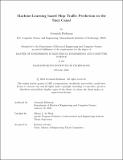| dc.contributor.advisor | de Weck, Olivier L. | |
| dc.contributor.author | Budiman, Jeremiah | |
| dc.date.accessioned | 2024-04-02T14:54:31Z | |
| dc.date.available | 2024-04-02T14:54:31Z | |
| dc.date.issued | 2024-02 | |
| dc.date.submitted | 2024-03-04T16:38:20.438Z | |
| dc.identifier.uri | https://hdl.handle.net/1721.1/153995 | |
| dc.description.abstract | This study implements and evaluates two approaches for predicting the average annual daily ship traffic (AADT) of ships within the Suez Canal with a focus on evaluating how deep-learning techniques can be leveraged for both approaches. The first approach is a novel method that utilizes both satellite imagery and AIS technology to predict the AADT. In order to do so, a 2-stage model is implemented that combines an image detection model followed by a correction factor model. The image detection model employs Mask R-CNN, a deep-learning neural network, and the correction factor model utilizes Long Short-Term Memory (LSTM), a recurrent neural network, to train on historical AIS data. Results of the 2-stage model using LSTM demonstrate positive indication of technical feasibility for the approach due to ground-truth AADT values falling within the interquartile range of predictions for all validation sets. Furthermore, although the interquartile ranges have considerable variation, the 2-stage model with LSTM had a mean absolute percentage error (MAPE) of 13.2% based on its median AADT predictions; this is a successful outcome especially when considering the high variance of vessel traffic and the noisiness that comes with satellite imagery’s small sampling rate as just snapshot moments in time. In addition to the 2-stage model, this study also implements a second approach involving a discrete-event simulation (DES) to estimate AADT, and we evaluate how the DES can benefit from using deep-learning techniques like LSTM. Results from the DES model with LSTM indicate an improved 90.8% reduction on the interquartile range of AADT predictions in comparison to that of the 2-stage model. Additionally, the DES model with LSTM had an MAPE of 3.8% for its median AADT predictions, demonstrating strong predictive accuracy. Overall, patterns within the AIS data indicate that despite the effects of Covid-19 in 2020, there is an increase in traffic in subsequent years especially in 2022 due to a rebound effect. | |
| dc.publisher | Massachusetts Institute of Technology | |
| dc.rights | In Copyright - Educational Use Permitted | |
| dc.rights | Copyright retained by author(s) | |
| dc.rights.uri | https://rightsstatements.org/page/InC-EDU/1.0/ | |
| dc.title | Machine-Learning based Ship Traffic Prediction in the Suez Canal | |
| dc.type | Thesis | |
| dc.description.degree | M.Eng. | |
| dc.contributor.department | Massachusetts Institute of Technology. Department of Electrical Engineering and Computer Science | |
| mit.thesis.degree | Master | |
| thesis.degree.name | Master of Engineering in Electrical Engineering and Computer Science | |
